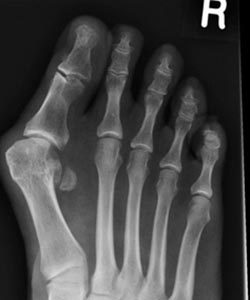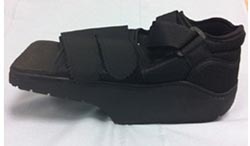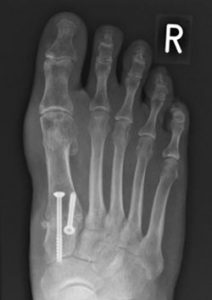 What will the surgery involve?
What will the surgery involve?
i. Anaesthetic – usually a general anaesthetic, you will have a chance to discuss this with the anaesthetist before the operation. You will also have local anaesthetic placed around your ankle (ankle block) or knee (popliteal block), which will make the foot partially or completely numb and should reduce the amount of pain you experience.
ii. Scars – two scars:
one on top of the foot
one on the inside of the foot at the base of the big toe
iii. The surgery – The joint in the middle of the foot that controls the overall position of the big toe becomes malaligned when a bunion (hallux valgus) develops, this malignment is corrected and the joint joined together (fused) with screws or a plate. This joint does not move very much anyway, so fusing it does not cause any problems. The tendons controlling the alignment of the big toe are then rebalanced (distal soft tissue release). One of the bones in the big toe itself may need to be realigned, this correction is secured with a staple or a screw (Akin osteotomy)
iv. Stitches – Dissolving sutures will usually be used to close the skin.
v. Dressings – Special dressings will be placed on the foot that will then be covered by a plaster (“of paris”)
The plaster will be changed in the outpatient clinic at two weeks after the surgery.
The plaster should be kept dry, applying a waterproof cover when showering is useful, the most commonly used can be found at www.limboproducts.co.uk
What happens after the surgery?
i. Going home – This will either be the same day or the following morning depending on the time of surgery and home situation.
ii. Pain relief – The local anaesthetic placed around the ankle or knee at the time of surgery, this will wear off several hours after surgery (if the local anaesthetic is placed behind the knee this usually lasts until the following day). It is important to take the pain relieving tablets regularly before the local anaesthetic wears off. You can gradually reduce the frequency with which you take these after twenty four hours.
 iii. Walking – You will not be able bear weight on the foot while it is in the plaster. The plaster will be changed at 2 weeks and the wound checked. The plaster will be changed to a post-operative shoe 4 weeks after surgery (see photo, right), which should be worn for the next 4 weeks. You should only place weight through your heel while you are wearing the post-operative shoe.
iii. Walking – You will not be able bear weight on the foot while it is in the plaster. The plaster will be changed at 2 weeks and the wound checked. The plaster will be changed to a post-operative shoe 4 weeks after surgery (see photo, right), which should be worn for the next 4 weeks. You should only place weight through your heel while you are wearing the post-operative shoe.
iv. Shoes – You will be able to wear normal shoes when the post-operative shoe is removed about 8 weeks after surgery.
You may not be able to fit into your usual shoes at this stage as the foot may be swollen, this can last up to 3 months (after the surgery).
You should avoid pointed shoes, as these will increase the chance of recurrence (the big toe drifting back across).
 v. Driving – You will not be able to drive until you can walk confidently after removing your post-operative shoe, this is usually eight weeks after surgery.
v. Driving – You will not be able to drive until you can walk confidently after removing your post-operative shoe, this is usually eight weeks after surgery.
If however you the surgery is on your left foot and you have an automatic car you may be able to drive after your two week review, but you should check with your insurance company first.
vi. Follow up – You will be seen in the outpatient clinic at:
2 weeks after surgery for wound review and change of plaster ’back slab’ to a full plaster.
4 weeks after surgery to remove the plaster and apply a heel wedge post operative shoe
8 weeks after surgery when an X-Ray will be obtained, if this is satisfactory you will be able to start walking in a normal shoe.
4 months after surgery, further follow up will then depend on your progress.
vii. Work – Returning to work will depend on your job:
Sedentary – 2 weeks
Mobile – 8-10 weeks
Manual labour – 12-14 weeks
What are the risks of the operation?
There are a small number of risks of surgery including infection, nerve damage, blood clots, ongoing pain and the need for further surgery (please see General Risks of Foot and Ankle Surgery for further information)
